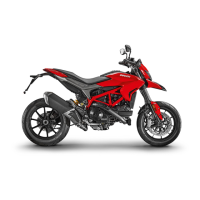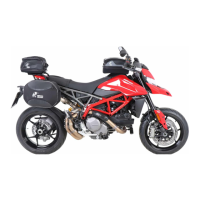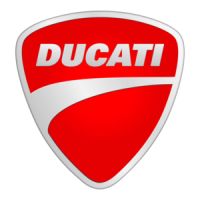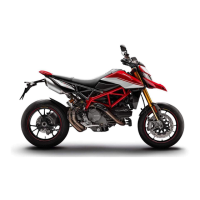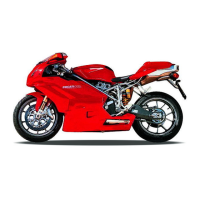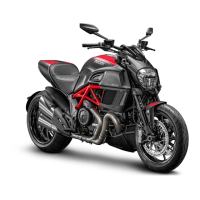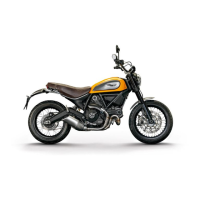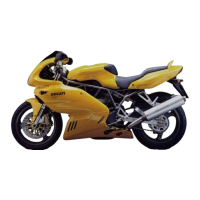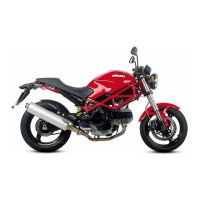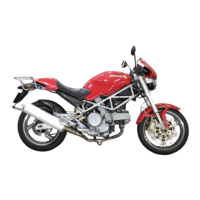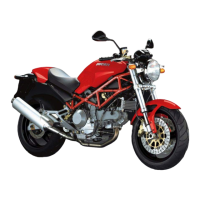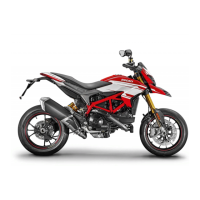
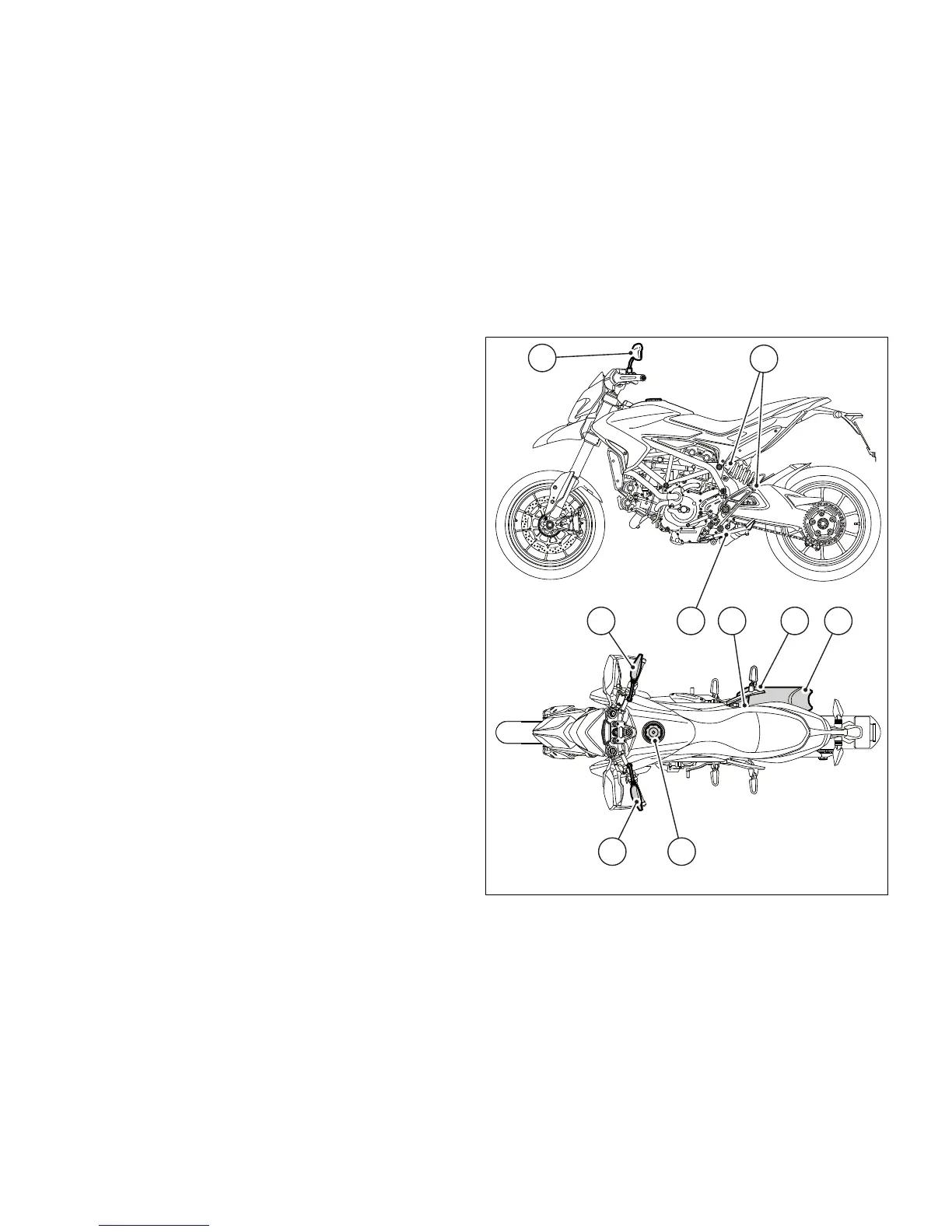 Loading...
Loading...
Do you have a question about the Ducati Hypermotard and is the answer not in the manual?
| Transmission | 6-speed |
|---|---|
| Frame | Tubular steel trellis frame |
| Engine Type | L-twin, 4 valves per cylinder, Desmodromic, liquid cooled |
| Torque | 71 lb-ft (96 Nm) @ 7, 250 rpm |
| Front Brake | 2 x 320mm semi-floating discs, radially mounted Brembo Monobloc 4-piston calipers |
| Rear Brake | 245mm disc, 2-piston caliper |
General introduction to the owner's manual and responsibilities.
Important safety information and warnings for riders.
Defines how and where the motorcycle can be used.
Responsibilities of the rider, including licensing and sobriety.
Recommendations for appropriate riding apparel for safety.
Essential rules for safe operation and motorcycle maintenance.
Instructions and safety precautions for refueling the motorcycle.
Guidelines and limits for carrying luggage and passengers.
Safety information regarding engine oil, brake fluid, and coolant.
Details on locating and understanding the VIN.
Information on how to find the engine identification number.
Diagram showing the location of various plates on the vehicle.
Explanation of the emission control system and its components.
Details of the emission control system warranty for California.
Specifies the duration and terms of the manufacturer's warranty.
Outlines the owner's duties for maintaining warranty validity.
Description of the California-specific evaporation emission system.
Legal terms and limitations of the emission control system warranty.
Identification and function of various indicators and displays.
Definitions of acronyms and abbreviations used in the manual.
Explanation of selectable riding modes and their impact.
Description of the DTC system and its intervention levels.
Explanation of the ABS system and its levels.
Details on the function and operation of handlebar controls.
Overview of data displayed on the main LCD screen.
Instructions for navigating and displaying information on the LCD.
Function and display details for the vehicle speed indicator.
Explanation of the engine RPM display and its operation.
Details on Odometer, trip meters, fuel consumption, and speed.
Display of coolant temperature, air temperature, and clock.
Indicates the currently selected riding mode and associated settings.
Information on service indicators and required maintenance.
How abnormal vehicle behavior and error codes are displayed.
Shows whether the lap time function is enabled or disabled.
Allows customization of riding modes, DTC, ABS, and engine power.
Customization of Ducati Traction Control intervention levels.
Customization of Anti-lock Braking System levels and disabling.
Customization of engine power output (HIGH, MEDIUM, LOW).
Restores all Ducati default setup parameters for riding modes.
Restores default parameters for a single selected riding mode.
Adjusts the intensity of the instrument panel backlighting.
Enables or disables the lap time recording function.
Describes how lap times are stored and managed.
Displays stored lap times, including speed and RPM.
Instructions for setting and adjusting the vehicle's clock.
Displays the current vehicle battery voltage status.
Shows numerical RPM values for accurate idle RPM setting.
Function to activate/edit PIN for temporary vehicle start.
Procedure for activating a new PIN for the immobilizer system.
Steps to modify the existing PIN code for the immobilizer.
Explanation of how the anti-theft immobilizer system works.
Information about the vehicle keys and their functions.
Temporary vehicle start procedure using PIN in case of malfunction.
Procedure and information for obtaining replacement keys.
Management of headlight switching for reduced current consumption.
How turn indicators automatically deactivate or can be manually cancelled.
Activation and deactivation of the hazard warning light function.
Allows changing display units for speed, temperature, and consumption.
Configuration of speed units (Km/h or mph).
Configuration of temperature units (°F or °C).
Configuration of fuel consumption units (L/100, Km/L, MPG).
Restores default units of measurement based on vehicle version.
Details on additional functions like the UP-MAP function.
Enabling and adjusting the heated grips for comfort.
Diagram and identification of all main controls.
Description of ignition switch positions and steering lock.
Functions of the left handlebar control switches.
Operation and adjustment of the clutch lever.
Functions of the right handlebar switches (ON/OFF, START).
How to operate the throttle for acceleration.
Operation and adjustment of the front brake lever.
Operation of the rear brake pedal.
How to operate the gear change pedal for shifting gears.
Procedure for adjusting gear and brake pedal positions.
Identification of key vehicle components.
Instructions for opening and closing the fuel tank filler plug.
Procedure for opening and closing the seat lock.
How to use the helmet security cable.
Proper use and operation of the side stand.
Adjusting rebound damping and spring preload.
Guidelines for the initial break-in period for optimal performance.
Essential checks to perform before each ride for safety and function.
Indication and function of the ABS warning light.
Information on the ABS system and its proper operation.
Step-by-step procedure for starting the engine.
Instructions on how to start moving from a standstill.
Techniques for effective and safe braking, including ABS use.
Procedure for bringing the motorcycle to a complete stop.
Guidelines for safely parking the motorcycle.
Procedure for checking and refilling engine coolant.
How to check and maintain brake and clutch fluid levels.
Procedure for inspecting brake pad thickness and replacement.
Instructions for safely charging the motorcycle battery.
Guidance on battery maintenance during periods of non-use.
Procedure for checking and adjusting drive chain tension.
Proper methods and products for lubricating the drive chain.
Step-by-step guide for replacing headlight bulbs.
Instructions for changing front and rear turn indicator bulbs.
Procedure for accessing and replacing the license plate light bulb.
Instructions for checking and adjusting headlight beam alignment.
Manual adjustment of the rear-view mirrors.
Information on tire pressure, repair, and replacement.
Specification for minimum tire tread depth.
Procedure for checking and topping up engine oil.
Guidance on spark plug maintenance and replacement.
Instructions and precautions for cleaning the motorcycle.
Maintenance schedule and tasks for authorized dealers.
Basic maintenance tasks the owner can perform.
Specifications for motorcycle weights and load limits.
Diagrams showing the external dimensions of the motorcycle.
Capacities and types of fluids and lubricants for top-ups.
Specifications for the motorcycle's engine.
Details on the desmodromic timing system.
Information on maximum speed and performance figures.
Specifications for the spark plugs used in the motorcycle.
Details on the fuel injection system and fuel requirements.
Specifications for the front and rear brake systems.
Details on the clutch, gearbox, and drive chain specifications.
Specifications of the motorcycle's frame and subframe.
Specifications for the motorcycle's wheels (rims and size).
Specifications for the front and rear tires.
Details on front fork and rear shock absorber specifications.
Description of the exhaust system components.
List of available color schemes and finishes for the motorcycle.
Overview of basic electrical components and specifications.
Information on the location and function of fuses.
Location and identification of front and rear fuse boxes.
Key to identify fuses in the front and rear fuse boxes.
Location and replacement procedure for the main fuse.
Key for components shown in the electrical system diagram.
List of wire colors and their corresponding designations.
Log for recording scheduled maintenance service history.
